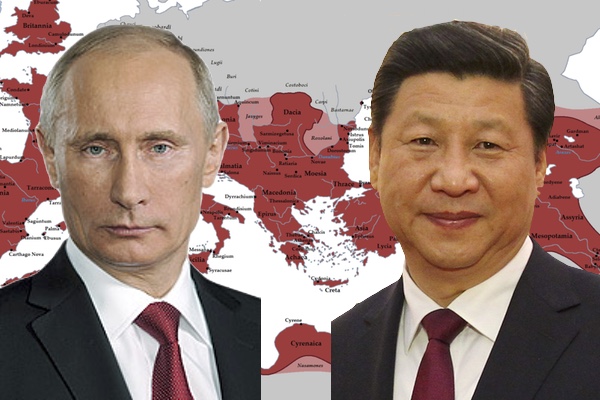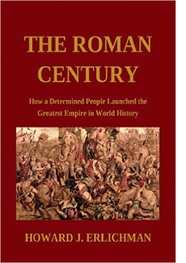Why Nobody Who Remembers the History of Rome Can Be Surprised by the Moves of Russia and China

There is nothing really new in the skillful forms of statecraft being practiced by Russian President Vladimir Putin in Ukraine and Syria and by Chinese President Xi Jinping in the East China Sea. The two men are following a long-established pattern of behavior in their efforts to exploit possible disunity in the opposing ranks, engage proxies to enhance their geo-political interests and court public opinion by availing themselves as objective mediators in regional affairs. Both leaders have relied on pretexts to further their strategic position.
 The Russian
President has presented himself as a defender of ethnic Russians in
Crimea and eastern Ukraine; as a stabilizing force in the campaign
against the Islamic State and in the general war against terrorism;
and as a prospective broker between western interests and an evolving
alliance among the Bashar al-Assad regime in Syria, the Republic of
Iran and their regional proxies. He has also exploited a longstanding dispute with Japan over the Kuril Islands to promote Russian interests in the Far East and support an emerging play on global warming in the Arctic. Xi Jinping has adopted a somewhat
different strategy. The Chinese President has essentially dared
anyone to challenge China’s authority in the East China Sea by
asserting control over some uninhabited islands – known
respectively as the Diaoyu (Chinese), Senkaku (Japanese) or Tiaoyutai
(Taiwanese) – and serving as an unpredictable influence on the
People’s Republic of North Korea.
The Russian
President has presented himself as a defender of ethnic Russians in
Crimea and eastern Ukraine; as a stabilizing force in the campaign
against the Islamic State and in the general war against terrorism;
and as a prospective broker between western interests and an evolving
alliance among the Bashar al-Assad regime in Syria, the Republic of
Iran and their regional proxies. He has also exploited a longstanding dispute with Japan over the Kuril Islands to promote Russian interests in the Far East and support an emerging play on global warming in the Arctic. Xi Jinping has adopted a somewhat
different strategy. The Chinese President has essentially dared
anyone to challenge China’s authority in the East China Sea by
asserting control over some uninhabited islands – known
respectively as the Diaoyu (Chinese), Senkaku (Japanese) or Tiaoyutai
(Taiwanese) – and serving as an unpredictable influence on the
People’s Republic of North Korea.
These forms of diplomacy, of course, have been around for centuries. But those who ponder the increasingly intense competition among the United States, Russia, China and emerging Islamic powers should consider the birth of the Roman Empire. The Romans were the true masters of statecraft. The untimely death of Alexander the Great in 323 BC would not have caused anyone to predict that the 185-year-old Roman Republic was capable of launching a sprawling multinational empire that would last, in its eastern form, until the fall of Constantinople in 1453.
The Roman federation was smaller in size than Los Angeles County, inhabited by less than 600,000 free citizens and woefully deficient in maritime affairs. Yet this modest regional enterprise proceeded in stepping-stone fashion to gain control of Central Italy (295), Southern Italy (272), Sicily (241), Sardinia (238) and large tributary slices of Spain (206), Tunisia (202), Macedon (197), Greece (191) and Anatolia (188) during the “long” 3rd century BC. The Romans advanced slowly and methodically They borrowed ideas from their foes – especially a multi-pronged blueprint of imperial conquest that had been introduced by Philip II of Macedon, applied in grand fashion by Alexander the Great and formalized by a series of Macedonian successors – and masked their territorial ambitions with a wildly-successful “protection-for-tribute” invasion model.
The Romans, in the words of Sun Tzu, learned to “conquer by strategy.” They developed a diabolical form of diplomacy which was pretext-based, extortionist in style and designed to present Rome as an objective mediator in regional affairs. The results spoke for themselves. The Roman Senate almost always found a pretext to “protect” a targeted city-state from a perceived adversary, reduce it to vassalage with a “protection-for-tribute” arrangement and gain access to a predictable stream of tributary soldiers (or wheat). The strategic alliance concluded with Thurii (283) helped to tighten the noose around Tarentum. The one with Hieron II of Syracuse (263) reduced eastern Sicily to vassalage and pushed the Carthaginians to the northwestern corner of the island. A later one with Masinissa of Numidia tipped the balance of cavalry power at the Battle of Zama (Tunisia) in 202. Those that followed on both sides of the Aegean Sea, anchored by Rome’s skillful acquisition of proxies in Macedon, Pergamon and Rhodes, encircled Antiochus III with enemies after the Battle of Cynoscephalae (197) and exposed Seleucid Anatolia to a full-scale invasion in 190. Machiavelli declared that “in all the world there remained neither prince nor republic that by itself or together [could] oppose the Roman forces” after the decisive triumph at the Battle of Magnesia (190).
The making and breaking of treaties had also been crucial. The Romans exploited the Treaty of 306 with Carthage – an amended agreement which recognized Punic authority in Sicily, Sardinia, North Africa and Southern Spain – and then circumvented the agreement when it was no longer useful. The treaty, in the meantime, induced the Etruscans to sever their ancient ties with Carthage, the Samnites to face a full-scale Roman invasion on their own between 295 and 290 and Pyrrhus of Epirus to think twice about marching on Rome after his remarkable triumphs at Heraclea (280) and Ausculum (279). The Romans also violated the agreement which ended the First Punic War in 241. That was by invading Sardinia in 238.
Polybius found it “impossible to find any reasonable pretext or ground for [a] Roman action [which] beyond question compelled [the Carthaginians] to evacuate Sardinia and to pay [an] enormous sum of money.” But the Carthaginians failed to heed the lessons of Sardinia. They of all people should not have been surprised by Rome’s willingness to strike a “protection” deal with the neutral city-state of Saguntum in Spain. The deal circumvented the Ebro Treaty of 225, an agreement which recognized Punic Spain, and helped to ignite the Second Punic War in 218.
The Macedonians and Seleucids, in turn, failed to heed the lessons of Carthage. Philip V of Macedon and Antiochus III allowed themselves to be isolated diplomatically by the Romans, who devised a brilliant “divide-and-conquer” strategy with the Greek world during the 190s, when some combination of Macedonians, Seleucids, Greeks and Carthaginians might have stopped the easterly-moving Romans for all time.
The Romans evolved into a so-called “rude element,” in the words of Clausewitz, who “knows no other law than that of his [own] intrinsic strength.” Statecraft was just as important to their spectacular advance as the application of brute military force, tributary finance and pure resiliency. It inspired more than a few ambitious rulers, most notably Adolph Hitler, to study Rome’s successful efforts to assemble (or subvert) strategic alliances, manufacture pretexts to mask aggressive behavior and make and break treaties.
History has a way of repeating itself. So once again, those who ponder the increasingly intense competition among the United States, Russia, China and emerging Islamic powers should consider the birth of the Roman Empire and learn from some of the most valuable lessons in world history.
Image Credits- "Roman Empire Trajan 117AD" by Tataryn - Own work. Licensed under CC BY-SA 3.0 via Commons. "Vladimir Vladimirovich Putin (2nd Presidency)" by Kremlin.ru. Licensed under CC BY 3.0 via Wikimedia Commons. "Xi Jinping October 2013 (cropped)" by Antilong - Own work. Licensed under CC BY-SA 3.0 via Commons.